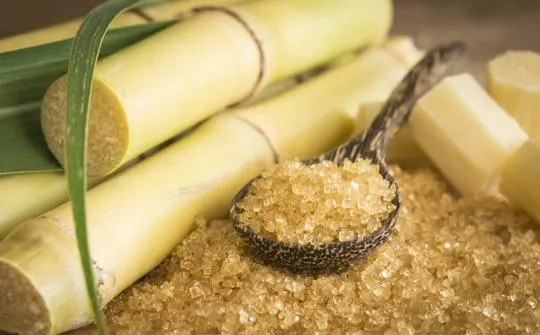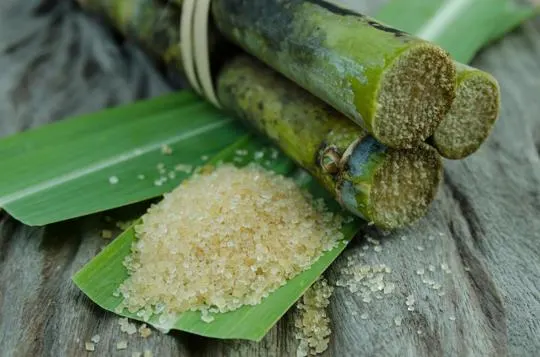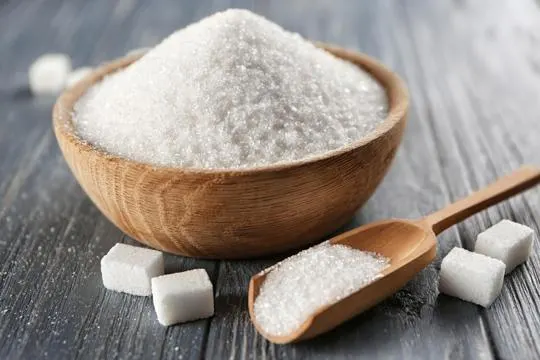Summary of key points
The main difference between cane sugar and white sugar is the way they are processed. Cane sugar is minimally processed, while white sugar undergoes a refining process that removes impurities and results in pure sucrose.
This distinction affects the flavor profile of each type of sugar, with cane sugar offering a subtle molasses taste and white sugar being more neutral in flavor. In baking, the type of sugar used can also affect the texture and moisture of the final product.
When it comes to health, both cane sugar and white sugar are essentially the same in terms of calorie content. However, some may prefer using less refined options like cane sugar for its potential trace minerals. Overall, both sugars can be used interchangeably in most recipes.
Cane sugar and white sugar duke it out in baking like two titans. We’re here to give you the scoop. Seriously, the difference matters!
Cane sugar is the cool, laid-back cousin. It’s less processed, keeping a hint of molasses vibe. White sugar? It’s the refined city slicker. All pure, no games.
Why care? Well, we’ve had our share of baking flops. Cookies that could double as hockey pucks. Cake denser than a fog in London.
Turns out, the sugar type plays detective in texture and taste. We learned the hard way. You don’t have to.
Ready for a sugar showdown? We’ve got front row seats.
What is Cane Sugar?

Cane sugar, also known as sucrose, is a type of sugar from sugarcane plants.
It’s popular in baking and adding flavor.
Cane sugar comes in many forms, such as granulated, powdered, and brown sugar.
The main difference between cane sugar and white sugar lies in processing.
Cane sugar has minimal processing, so it retains natural molasses.
This gives it a darker color and stronger flavor compared to white sugar.
Cane sugar has bigger crystal size than white sugar.
This can affect the texture of baked goods, making them coarser or crunchier.
Cane sugar is favored by those who prefer natural ingredients.
It’s less refined than white sugar since it goes through fewer steps during production.
Both cane sugar and white sugar can be used interchangeably in most recipes without much impact.
The choice between the two depends on your taste and desired flavor profile.
Ultimately, decide between cane sugar or white sugar based on your taste and texture preference.
Both sugars have their own unique characteristics that can enhance sweetness and appeal.
What is White Sugar?

White sugar is a highly-refined sweetener. It comes from sugar cane or sugar beets.
It has a fine texture and easily dissolves, making it perfect for baking.
It adds sweetness and enhances flavors in many recipes like cookies and cakes.
This versatile ingredient is great for creating texture and taste in baked goods.
Whether you’re making pancakes or brownies – white sugar adds sweetness without changing the flavor profile.
Its small crystal size makes it blend easily with other ingredients.
It also helps preserve baked goods due to its hygroscopic nature.
It retains moisture, keeping them fresh for longer.
Plus, when heated, it caramelizes and creates a golden brown color on the surface of pastries and desserts.
White sugar is an essential ingredient that goes beyond just sweetness.
It’s a natural preservative and contributes to the appearance of finished products.
Don’t underestimate it – whether you’re a pro baker or just starting out.
Differences Between Cane Sugar and White Sugar in Baking

Cane and white sugar look similar, but their baking effects differ.
Source and Processing
Cane sugar and white sugar have different sources and methods of processing.
Cane sugar comes from sugarcane plants.
White sugar can be taken from either sugarcane or sugar beets.
The processing for both types of sugar involves extracting the natural sugars and purifying them to remove impurities.
For cane sugar, it is produced by crushing the stalks and then extracting the juice.
This juice then goes through clarification, filtration, and evaporation.
Lastly, it is crystallized to obtain raw cane sugar.
White sugar is obtained by extracting the juice from either sugarcane or beets.
After that, heating, filtration, and centrifugation are used to remove impurities and decolorize the syrup.
It is then evaporated into crystals.
The main difference between cane and white sugar is in their flavor.
Cane sugar has a molasses-like taste while white sugar has a neutral taste.
This difference impacts the final outcome of baked goods.
Cane sugar also has larger crystals than white sugar.
This affects how they dissolve or interact with other ingredients.
But, both can generally be used in recipes interchangeably without major changes in results.
Flavor and Taste
Cane sugar and white sugar have different flavors.
Cane sugar comes from sugarcane plants.
It’s sweet with a hint of caramel and molasses.
White sugar has been more processed. It’s milder and sweeter.
So, when baking, it is up to you to decide which type of sugar you want for the desired flavor.
Texture and Moistness
When it comes to baking, the choice between cane sugar and white sugar can make a difference.
Both types have their unique characteristics.
Cane sugar is less refined and has a caramel-like flavor due to its natural molasses content.
This adds depth and contributes to a soft texture.
It also holds moisture, keeping treats moist for longer.
White sugar is highly refined and processed.
It has a milder taste and produces lighter, fluffier results.
But it may become drier faster due to its lack of moisture-retaining properties.
To get the desired texture & moistness, consider the qualities of each sugar.
For softer & moister results with a hint of caramel, opt for cane sugar.
For lighter & fluffier results with a milder sweetness, go with white sugar.
Color and Appearance
Color and appearance play a crucial role in baking.
They not only make your treats look pretty, but they also affect how they taste.
Cane sugar and white sugar differ in color and texture.
Cane sugar is light brown or golden due to molasses.
It’s granules are bigger than white sugar, giving your treats a crunchy feel.
Molasses also makes your baked goods softer and moister.
On the other hand, white sugar has a cleaner, more uniform look.
It allows colors to shine through.
Nutritional Comparison of Cane Sugar and White Sugar
When baking, there’s a choice between cane sugar and white sugar.
Cane sugar has a subtle molasses flavor and golden color, while white sugar is brighter and has been refined to remove impurities.
Nutritionally, they both have a similar sucrose content.
However, cane sugar retains vitamins and minerals from the sugarcane plant, plus a higher moisture content.
These differences can affect the final product.
Cane sugar adds depth, while white sugar is more neutral.
The higher moisture content in cane sugar results in a softer texture.
Both should be eaten in moderation.
But if you’re looking for trace minerals or a unique flavor, go for cane sugar.
For a more neutral sweetness or a white appearance, white sugar is best.
Substituting Cane Sugar and White Sugar in Baking

Swapping cane and white sugar in baking can make a huge difference in the outcome.
Here are three things to think about:
- Taste: Cane sugar can give a caramelly flavor to baked goods. White sugar is much milder in taste.
- Texture: Cane sugar can add moisture, making baked goods softer and chewier. White sugar can make them crispier.
- Color: Cane sugar is brown because of molasses, which can give products an amber color. White sugar will keep the original color.
It’s worth mentioning that cane sugar is less processed than white sugar.
This means it may have some trace minerals and nutrients that are lost when white sugar is processed.
1 – One-to-One Substitution
When it comes to swapping cane sugar for white sugar in baking, one-to-one substitution is key.
Both sugars may look alike, but have unique qualities and effects on the end product.
Texture-wise, cane sugar is coarser and retains more moisture.
White sugar is finer and drier.
This means replacing cane sugar with white sugar can lead to a drier texture in baked goods.
Flavor-wise, cane sugar has a delicate molasses taste that adds complexity to recipes.
While white sugar gives a cleaner, more neutral flavor.
Therefore, when replacing cane sugar with white sugar, there may be a slight difference in taste.
Caramelization also differs between cane and white sugar due to their different compositions.
Cane sugar contains tiny amounts of molasses, which give it a golden brown hue when caramelized.
White sugar has no impurities, so it produces a lighter-colored caramel.
One-to-one substitution is possible with both sugars in most recipes.
But, it’s important to note the differences for the best results.
It may take some trial-and-error to get the right texture and flavor in baked goods.
In conclusion, understanding the distinctions between cane sugar and white sugar can make a huge difference in baking.
Both can be used as a one-to-one substitute, yet their contrasting textures, flavors, and caramelization processes make them two distinct ingredients with subtle variations in the final product.
2 – Adjusting for Moisture Content
Adjusting for moisture is key when baking with different sugars.
Moisture level can affect the texture of your baked goods.
It’s important to know the difference between cane and white sugar.
Cane sugar is raw, unrefined, and contains more moisture, due to its natural molasses content.
It’s stickier and clumps together easily.
When using cane sugar, you may need to reduce liquid ingredients or increase dry ingredients to account for the extra moisture.
White sugar has been processed and refined, removing impurities and moisture.
It has a finer texture and flows more freely.
Recipes that call for white sugar may require extra liquid ingredients.
Variations in moisture content can depend on brand and storage conditions.
It’s best to adjust recipes depending on the type and brand of sugar used.
3 – Flavor Considerations
When it comes to baking, flavor is key.
You have the choice between cane sugar and white sugar; each can impact the taste of your treats.
Cane sugar retains more of its natural molasses, giving a richer, complex flavor.
White sugar has a milder note, allowing other ingredients to shine.
Both have merits, so it depends on the desired outcome.
Cane sugar’s larger crystals suit chewy or crispy recipes.
The molasses adds moisture, giving a soft and moist finished product.
White sugar’s finer texture dissolves quickly and evenly – great for cakes and pastries that need a fine crumb structure.
Colour also differs – cane sugar has a golden hue due to molasses, while white sugar is colourless from the refining process.
Aesthetics or recipe requirements may influence the presentation of your goodies.
It comes down to personal preference and desired outcome.
Each sugar brings a unique flavor to the plate; one may elevate or complement other ingredients.
Experiment with both types and discover which suits your taste and culinary goals.
Common Baked Goods Using Cane Sugar and White Sugar
For baking, both cane sugar and white sugar are popular.
They have different traits which can improve a treat’s taste and texture.
Cane sugar is also known as raw or natural sugar.
It’s minimally processed and has a little molasses, making it golden and with a slight caramel flavor.
It’s a great choice for recipes needing complex sweetness like chocolate chip cookies or carrot cake.
White sugar is highly refined and has no molasses.
This gives it a white color and neutral taste.
It’s good to use in recipes wanting a plain sweetness, like vanilla cupcakes or shortbread cookies.
Cane sugar and white sugar can be used interchangeably in recipes.
But their special characteristics can affect the result of certain baked goods.
Cane sugar’s caramel flavor may boost a fudgy brownie’s richness.
While white sugar’s neutrality could help delicate pastries, like macarons, really stand out.
The decision between cane sugar and white sugar depends on individual preference and the flavor profile of the baked goods.
Trying different sugars can add complexity to homemade treats and make them even better.
So, unleash your creativity and explore the joy each type of sugar can bring to baking.
Conclusion
White sugar and cane sugar may appear incredibly similar to the naked eye, but don’t be fooled.
After closely examining the differences between these sugars, one will understand that there is a lot more complexity at play than meets the eye.
We now know that not only are these two types of sugars unique in terms of taste and popularity, but in terms of their production methods and overall composition as well.
Bakers across many different mediums can benefit from being informed on the intricacies between these two sugars while attempting to meet their desired outcomes in recipes calling for either type of sugar.
Furthermore, this knowledge isn’t solely beneficial to professional bakers; it stands true adequate for home bakers looking to bring out unique flavors and textures within their desserts.
Ultimately, everyone interested in baking should take time into learning more about the subtle nuances between both cane and white sugar – no one else knows what they need to accomplish from their recipes better than you do.

Leave a comment